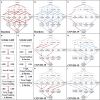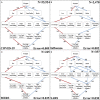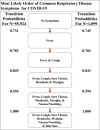Modeling the Onset of Symptoms of COVID-19
- PMID: 32903584
- PMCID: PMC7438535
- DOI: 10.3389/fpubh.2020.00473
Modeling the Onset of Symptoms of COVID-19
Abstract
COVID-19 is a pandemic viral disease with catastrophic global impact. This disease is more contagious than influenza such that cluster outbreaks occur frequently. If patients with symptoms quickly underwent testing and contact tracing, these outbreaks could be contained. Unfortunately, COVID-19 patients have symptoms similar to other common illnesses. Here, we hypothesize the order of symptom occurrence could help patients and medical professionals more quickly distinguish COVID-19 from other respiratory diseases, yet such essential information is largely unavailable. To this end, we apply a Markov Process to a graded partially ordered set based on clinical observations of COVID-19 cases to ascertain the most likely order of discernible symptoms (i.e., fever, cough, nausea/vomiting, and diarrhea) in COVID-19 patients. We then compared the progression of these symptoms in COVID-19 to other respiratory diseases, such as influenza, SARS, and MERS, to observe if the diseases present differently. Our model predicts that influenza initiates with cough, whereas COVID-19 like other coronavirus-related diseases initiates with fever. However, COVID-19 differs from SARS and MERS in the order of gastrointestinal symptoms. Our results support the notion that fever should be used to screen for entry into facilities as regions begin to reopen after the outbreak of Spring 2020. Additionally, our findings suggest that good clinical practice should involve recording the order of symptom occurrence in COVID-19 and other diseases. If such a systemic clinical practice had been standard since ancient diseases, perhaps the transition from local outbreak to pandemic could have been avoided.
Keywords: COVID-19; Markov; disease; influenza; model; probability; stochastic; symptoms.
Copyright © 2020 Larsen, Martin, Martin, Kuhn and Hicks.
Figures






Similar articles
-
Modeling the onset of symptoms of COVID-19: Effects of SARS-CoV-2 variant.PLoS Comput Biol. 2021 Dec 16;17(12):e1009629. doi: 10.1371/journal.pcbi.1009629. eCollection 2021 Dec. PLoS Comput Biol. 2021. PMID: 34914688 Free PMC article.
-
Travel-related control measures to contain the COVID-19 pandemic: a rapid review.Cochrane Database Syst Rev. 2020 Oct 5;10:CD013717. doi: 10.1002/14651858.CD013717. Cochrane Database Syst Rev. 2020. Update in: Cochrane Database Syst Rev. 2021 Mar 25;3:CD013717. doi: 10.1002/14651858.CD013717.pub2. PMID: 33502002 Updated.
-
Association of Search Query Interest in Gastrointestinal Symptoms With COVID-19 Diagnosis in the United States: Infodemiology Study.JMIR Public Health Surveill. 2020 Jul 17;6(3):e19354. doi: 10.2196/19354. JMIR Public Health Surveill. 2020. PMID: 32640418 Free PMC article.
-
Seasonal influence on respiratory tract infection severity including COVID-19 quantified through Markov Chain modeling.CPT Pharmacometrics Syst Pharmacol. 2023 Sep;12(9):1250-1261. doi: 10.1002/psp4.13006. Epub 2023 Jul 10. CPT Pharmacometrics Syst Pharmacol. 2023. PMID: 37401774 Free PMC article.
-
Biological, clinical and epidemiological features of COVID-19, SARS and MERS and AutoDock simulation of ACE2.Infect Dis Poverty. 2020 Jul 20;9(1):99. doi: 10.1186/s40249-020-00691-6. Infect Dis Poverty. 2020. PMID: 32690096 Free PMC article. Review.
Cited by
-
Clinical Features and Treatment Outcome of Coronavirus and Tuberculosis Co-Infected Patients: A Systematic Review of Case Reports.Infect Drug Resist. 2022 Jul 27;15:4037-4046. doi: 10.2147/IDR.S370837. eCollection 2022. Infect Drug Resist. 2022. PMID: 35924015 Free PMC article. Review.
-
COVID-19 pandemic in Uttarakhand, India: Environmental recovery or degradation?J Environ Chem Eng. 2021 Dec;9(6):106595. doi: 10.1016/j.jece.2021.106595. Epub 2021 Oct 19. J Environ Chem Eng. 2021. PMID: 34692403 Free PMC article.
-
High association of COVID-19 severity with poor gut health score in Lebanese patients.PLoS One. 2021 Oct 21;16(10):e0258913. doi: 10.1371/journal.pone.0258913. eCollection 2021. PLoS One. 2021. PMID: 34673813 Free PMC article. Clinical Trial.
-
Risk Factors for Long COVID in Older Adults.Biomedicines. 2023 Nov 8;11(11):3002. doi: 10.3390/biomedicines11113002. Biomedicines. 2023. PMID: 38002002 Free PMC article. Review.
-
Corticosteroids showed more efficacy in treating hospitalized patients with COVID-19 than standard care but the effect is minimal: A systematic review and meta-analysis.Front Public Health. 2022 Jul 22;10:847695. doi: 10.3389/fpubh.2022.847695. eCollection 2022. Front Public Health. 2022. PMID: 35937252 Free PMC article.
References
-
- Cascella M, Rajnik M, Cuomo A, Dulebohn SC, Di Napoli R. Features, Evaluation and Treatment Coronavirus (COVID-19). StatPearls Publishing; (2020). - PubMed
Publication types
MeSH terms
Grants and funding
LinkOut - more resources
Full Text Sources
Other Literature Sources
Medical
Miscellaneous

